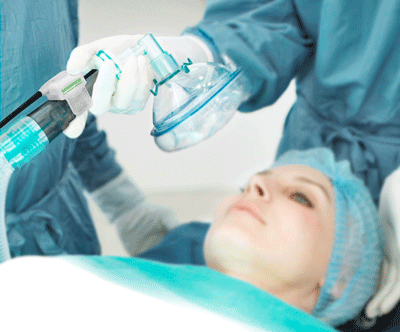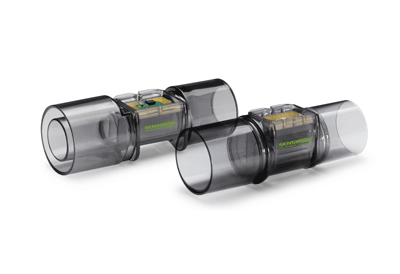
Autoclavable Mass Flow Meters
Reusable
Sensors for Proximal and Expiratory Flow Metering During Ventilation
The worldwide swine flu epidemic of 2009/2010, Ebola in Africa
in 2014, the MERS outbreak in South Korea in 2015 - the list
could be extended at will and makes one thing clear: that viruses
and other pathogens can spread worldwide in no time. Hospital
patients trust that they will receive the best possible care
and treatment. But as the
current debate regarding multiresistant germs has shown, pathogens
can spread like wildfire even in hospital environments. If hospitals
are to stop pathogens and germs efficiently, they need either
disposable equipment or components that can be disinfected and
sterilized after use.
Sensirion has been developing and marketing flow metering sensors
for many years. Until now, these sensors have been used in ventilation
and anesthetic devices to measure the volume of clean air administered
to the patient. But apart from this clean tract, both ventilation
and anesthetic procedures need a means of metering the flow of
exhaled air. This is known as either proximal or expiratory flow
metering. In both cases, the sensor comes into contact with air
from the patient that is potentially infected with germs and
pathogens. These sections of the apparatus are therefore comprised
of disposable parts or hygienically sterilizable. For the sterilization
process, a number of approaches are possible.
Conventional
Metering Solutions
The solutions used today are either hot-wire anemometers or (variable)
apertures combined with a differential pressure sensor. However,
the sensor is not always exchangeable or sterilizable. In measurements
involving the differential pressure process particularly, only
the metering section is replaced. The actual sensor, however,
is not
replaced or sterilized. Indeed, in situations like these, long
tubes running to the patient circuit should ensure that no air
comes into direct contact with the sensor.
In contrast to this situation, hot-wire sensors can usually be
replaced in their entirety or sterilized. The delicate hot wires,
however, are relatively sensitive to mechanical stresses and
strains: this can lead to problems during cleaning, particularly
thermal disinfection.

New Reusable
Solution
Now Sensirion has developed new flow metering devices that are
autoclavable and can be washed. The new SFM3200-AW and SFM3300-AW
mass flow meters1 are ideal for applications involving expiratory
and proximal ventilation. The CMOSens® technology used by
Sensirion is extremely resistant to environmental influences,
which makes CMOSens® flow sensors ideal for applications
where sterilization is required.
Sensirion’s newly developed flow sensors have been comprehensively
verified. The chip-based sensor component was tested for more
than 1000 hours at 150°C. Apart from this, test results are
available which show that the sensor components have withstood
1000 temperature variation cycles involving switches from -40°C
to 140°C. The results confirm the outstanding zero-point
stability of the metering component and of the electronics that
process the signals. Aging models have consequently suggested
that the offset drift over a ten-year lifespan is smaller than
0.2 slm.
Apart from the sensor element itself, the main issue with sterilizable
solutions is the choice of materials in the development process.
In the new flow sensors, the plastic selected for the sensor
housing is a polyphenylsulfone (PPSU) material. PPSU has outstanding
thermal properties and is better suited to handling the inhalation
anesthetics used for anesthetic purposes than other types of
plastic.
In addition to these main components, particular attention was
also paid to the adhesives and sealants used, with a view to
achieving lasting stability and a high number of autoclaving
cycles.
1 Detailed specifications of the two autoclavable sensor products
can be found in the additional information at the end of this
article. © Copyright Sensirion AG, Switzerland 2/4
Stability
Tested After Autoclaving and Cleaning
As part of the product development process, the SFM3200-AW and
SFM3300-AW mass flow meters were meticulously checked for their
suitability for treatment in an autoclave. Apart from this, the
stability of the sensors was tested after immersion in and sterilization
with CIDEX® Activated Dialdehyde Solution. The aim of the
tests was to show that they can be used for these processes.
Their suitability for sterilization in an autoclave was
selected because steam is a particularly low-cost method of sterilization.
An affordable form of processing also means a lower total cost
of ownership for the hospital and by extension patients and their
health insurance companies.
To test the suitability of the mass flow meters in the autoclave,
60 sensors – thirty of each type – were processed 50
times in the autoclave2. In each of the 50 cycles, the sensors
underwent five minutes’ exposure to a maximum temperature
of 135°C at an overpressure of +2.15 bar. Finally, the chamber
was evacuated (-0.8 bar) and then
cooled to 50°C at atmospheric pressure. An intermediate measurement
was taken after every ten cycles. The sensors were tested for
tightness and accuracy. The tightness test was carried out at
250 mbar overpressure and considered successful if no leak greater
than 0.01 slm appeared. As regards precision, the sensor likewise
passed the relevant tests and fulfilled the specifications listed
in the data sheet3. The results of the precision
measurement are shown in Figure 1. It is once again important
to note their high-level zero-point stability. All sensors have
a zero-point drift of less than 0.1 slm. Even after 50 cycles
in the autoclave, 59 out of 60 sensors were still within the
tolerances. In other words, the sensors can be prepared for subsequent
use more than 50 times. Depending on the autoclave used, results
may vary, although the temperature of 135°C represents a
demanding process cycle.3 The test for washability with CIDEX®
Activated Dialdehyde Solution was carried out on a total of eight
sensors.
After ten cycles each, involving 15 minutes immersion and subsequent
drying, there were absolutely no observable effects. For this
reason, additional testing was accelerated and the sensor was
immersed in the solution for over 25 hours, corresponding to
approximately 100 cycles. Finally, the test was carried out under
the same conditions as for the autoclave. After testing, all
eight sensors were fully functional and within the
prescribed tolerances.
The details and results of these tests are available in a separate
application note from Sensirion4.
Sterilizable
Flow Sensors or Disposables
Apart from the need for reusable sensors, whether sterilized
in the autoclave or simply disinfected, there are also applications
where the use of disposable products is becoming increasingly
widespread. With the right production volume, the CMOSens®
Technology used by Sensirion brings down the unit price and is
therefore suitable for disposable products. Sensirion is currently
working on the development of a one-way product in the form of
a simplified sensor without sieves. The one-way sensor is due
for market launch within the next year.
Various
Application Fields
Both the SFM3200-AW and SFM3300-AW sensors were developed for
expiratory and proximal applications and are therefore suitable
for use in both intensive and home ventilation. WEINMANN Emergency
Medical Technology GmbH + Co. KG is set to become the first customer
to use the sensor in the particularly demanding
fields of emergency ventilation and ventilation during transport.
During development, Sensirion liaised closely with WEINMANN Emergency
with a view to optimizing the suitability of the sensor for its
intended future use.
Compared with clinical applications, emergency rescue services
are confronted with several special problems, particularly when
using the ventilation system at sub-zero temperatures. In the
course of development, WEINMANN Emergency also tested the sensor
for use in these difficult and demanding scenarios.
2 The sensors were tested using a Laboklav 80 MSLV autoclave.
3 The data sheet can be found on our website at www.sensirion.com/mfm-download.
4 The application note can be found on our website at www.sensirion.com/mfm-download.
© Copyright Sensirion AG, Switzerland 3/4
In view of its many years of experience with flow sensors for
critical-scenario ventilation, WEINMANN Emergency has always
kept a close eye on the benefits for patients and emergency service
personnel during sensor development. Thanks to their experience,
a number of important factors could be taken into account from
the very start while developing sensors, which is why cooperation
with the company has proved so constructive and effective. WEINMANN
Emergency currently uses a hot-wire-based sensor and has also
decided to use sensors from Sensirion. According to Ulrich Palm,
head of development at WEINMANN Emergency, the company was convinced
by the benefits of these sensors. "We decided to go with
tried-and-tested CMOSens® technology for three reasons: the
low-level breathing resistance, the high precision and stability
of the metering signal, and the rugged mechanical and electrical
design.”
February 2016

